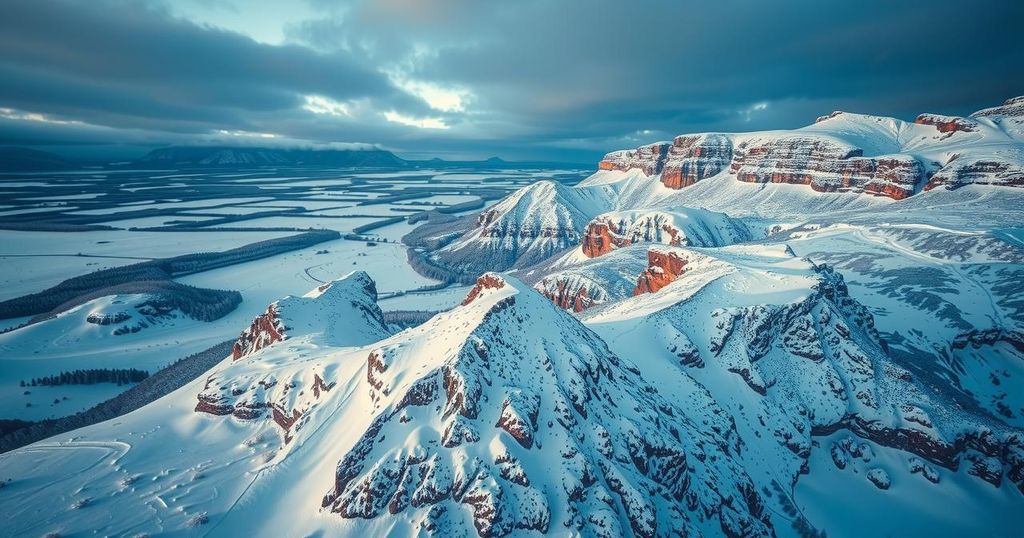Unexpected Snow: Seven African Nations That Experience Snowfall
Snowfall is a rare but fascinating phenomenon in Africa, occurring in various high-altitude regions across the continent. Notably, seven countries—South Africa, Morocco, Lesotho, Tanzania, Uganda, Algeria, and Ethiopia—experience snowfall due to their unique geographical features and elevations, highlighting Africa’s climatic diversity.
Africa is often perceived as a continent dominated by warmth, yet certain regions display a surprising phenomenon: snowfall. This distinctive weather occurrence can be attributed to various geographical features, particularly high elevations. Snow transforms these areas during the winter months, inviting curiosity as individuals travel to observe this rare spectacle. The presence of snow also illuminates the remarkable climatic diversity across Africa, dismantling conventional perceptions and revealing the continent’s rich natural environments. Seven African nations are known to experience snowfall: 1. South Africa – In South Africa, while the majority of the country enjoys a temperate climate, regions such as Gauteng, parts of Johannesburg, the Drakensberg Mountains, and some areas in the Western Cape can witness snowfall. Though not prevalent nationwide, these specific locales can present icy landscapes during the winter, offering a refreshing outlook on South Africa’s climatic variation. 2. Morocco – Renowned for its varied topography, Morocco is home to regions that regularly receive snow, particularly in the Atlas Mountains. The High and Middle Atlas ranges, especially in the town of Ifrane, attract visitors drawn to its Swiss-like ambiance and winter charm. 3. Lesotho – Lesotho, a landlocked country where every part is situated above 1,000 meters, stands out for its likelihood of snowfall. During the winter months from June to August, its high-altitude terrain may transform into a winter wonderland, providing extraordinary experiences for locals and tourists alike. 4. Tanzania – In Tanzania, snowfall predominantly occurs atop Mt. Kilimanjaro, Africa’s tallest peak. Although many regions experience cool temperatures, the summit encounters arctic conditions, particularly from mid-June to October. Snow typically appears in December, appealing to climbers seeking to encounter this unique climate. 5. Uganda – Uganda’s snowfall is primarily concentrated in the Rwenzori Mountains, where snow-capped peaks and glaciers create a stunning contrast with the surrounding landscapes. Adventurous individuals often trek these heights to witness the rare sight, whereas others appreciate the views from lower areas. 6. Algeria – Though snowfall is uncommon in Algeria’s predominantly arid climate, the Tell Atlas features higher altitudes that receive snow during winter months. Certain northern mountainous regions, notably the Kabylie and Aurès Mountains, undergo a temporary transformation brought on by snowfall, breaking the usual dry conditions. 7. Ethiopia – Ethiopia’s diverse terrains mean that some regions occasionally experience snow. The Simien Mountains, a UNESCO World Heritage Site, attain heights over 4,500 meters, making them one of the few locations to witness snowfall. This phenomenon not only fascinates hikers but also provides an opportunity to explore unique landscapes.
The occurrence of snowfall in Africa challenges prevalent assumptions about the continent’s climate, which is largely recognized for its warmth. This phenomenon typically arises in high-altitude areas where temperatures can fall sufficiently low during winter months. The advent of snow invokes excitement and adventure, as travelers and locals alike venture into the affected regions to witness the unexpected.
In summary, while Africa is widely known for its warm climates, several countries exhibit unique geographical traits that allow for snowfall. These seven nations—South Africa, Morocco, Lesotho, Tanzania, Uganda, Algeria, and Ethiopia—offer diverse climatic conditions and stunning winter landscapes, demonstrating the continent’s rich environmental diversity and challenging traditional views of its climate.
Original Source: businessday.ng




Post Comment